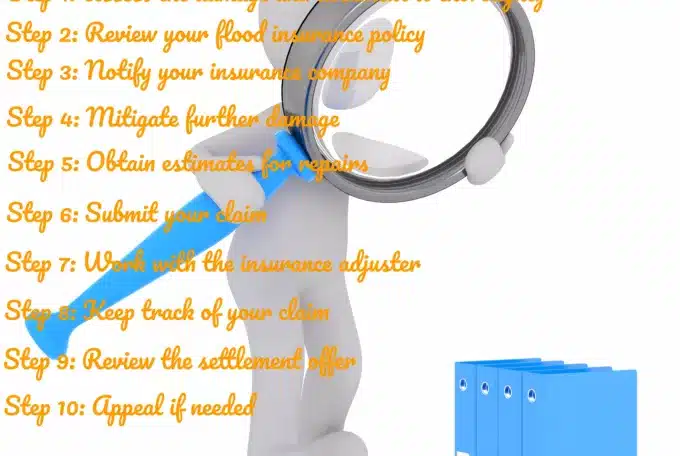Flood Recovery: What You Need to Know and Do to Recover
Floods can wreak havoc on homes, leaving homeowners devastated and unsure where to begin recovery. In the aftermath of a flood, taking immediate action is crucial to minimize damage and ensure a smooth recovery. That’s why we, Fraser Property & Adjusting, Florida’s leading public adjusters, have put together a comprehensive step-by-step guide to help homeowners navigate the challenging process of flood recovery. From assessing damage to filing insurance claims, our guide covers everything you need to know and do to recover from a flood and restore your home to its former glory. Don’t let the overwhelming aftermath of a flood discourage you – with the proper knowledge and support, and you can get through this challenging time and rebuild your home.
Step 1: Assess the Damage
After a flood, it’s crucial to assess the damage to your property as soon as it is safe. Start by taking photographs or videos of the affected areas to document the extent of the damage. This will be important for insurance claims and any potential disputes. Carefully inspect the structure of your home, including the foundation, walls, and ceilings, for any signs of cracks, water penetration, or structural damage. Check the electrical, plumbing, and HVAC systems for water damage or malfunctions. Take note of any damaged personal belongings or furniture. It’s essential to be thorough during this assessment process to ensure all damages are correctly identified and accounted for.
Step 2: Keep Safe
Step 2: Keep Safe
After a flood, it is crucial to prioritize your safety and your family’s safety. Here are some essential steps to follow:
1. Do not enter your home until it has been deemed safe by professionals. Floodwaters can cause structural damage and pose electrical hazards. Wait for authorities or experts to give the all-clear before reentering your property.
2. Turn off the electricity. If you can safely access your electrical panel, switch off the main circuit breaker to prevent the risk of electrocution. If unsure or uncomfortable doing this, wait for a professional to handle it.
3. Beware of potential hazards. Floodwaters can carry contaminants, sharp objects, and dangerous debris. Wear protective clothing like rubber boots and gloves when navigating through flooded areas. Be cautious of unstable surfaces and hidden dangers.
4. Avoid contact with floodwater. The water may be contaminated with sewage, chemicals, or other harmful substances. If you must come into contact with it, use waterproof gloves and boots, and wash your hands thoroughly afterward.
Remember, safety and well-being should be the top priority during a flood. Follow these steps and seek professional assistance to ensure a safe recovery process.
Step 3: Look for Temporary Housing if Necessary
After a flood, your home may be uninhabitable due to extensive damage. In such cases, it is essential to find temporary housing for you and your family. Start by reaching out to friends or family members who may be able to accommodate you temporarily. If that is not an option, consider checking with local hotels, motels, or rental properties for availability. Additionally, you can contact organizations such as the Red Cross or FEMA for assistance in finding suitable temporary housing. Remember to keep all receipts related to your temporary housing expenses, as these may be reimbursable by your insurance company. It is crucial to prioritize the safety and well-being of your family during this challenging time.
Step 4: File your Insurance Claim
After experiencing a flood, filing an insurance claim as soon as possible is crucial. Contact your insurance company and provide them with all the necessary information regarding the flood damage. This includes documenting the extent of the damage with photographs or videos, listing any damaged items or property, and providing any relevant documents such as receipts or appraisals.
When filing your claim, be sure to provide accurate and detailed information about the flood, including the cause and extent of the damage. It is essential to be thorough and transparent to ensure a smooth claims process.
Additionally, keep track of all communication with your insurance company, including each conversation’s names, dates, and details. This will help you stay organized and provide evidence of your efforts in case of any disputes or delays.
Remember, acting quickly when filing an insurance claim after a flood is essential. The sooner you file, the sooner you can start recovering and repairing your home.
Step 5: Assess the Necessary Repairs and Hire Contractors
Once you’ve completed your claims process, assessing the necessary repairs and hiring contractors is essential. Start by contacting reputable contractors who specialize in flood damage restoration. Get multiple quotes and compare their expertise, prices, and availability. Make sure to ask for references and check their credentials. It is also advisable to work with public adjusters like Fraser Property & Adjusting, who can assist you in negotiating with your insurance company and ensuring that you receive the maximum compensation for the repairs. Remember to keep all receipts and records related to the repairs for future reference.
Contact your public adjuster.
We hope our step-by-step guide on what to do after a flood has helped provide you with the necessary information and guidance. However, navigating the insurance claim process can still be overwhelming. That’s where we come in as public adjusters specializing in flood damage claims in Florida.
If you need assistance, don’t hesitate to reach out to Fraser Property & Adjusting. Our team of experienced public adjusters is here to help you navigate the intricacies of your insurance claim, ensuring you receive the maximum compensation you deserve.
Remember, time is of the essence when filing an insurance claim, so don’t delay contacting us. Fill out our form on the website or give us a call to schedule a consultation, and let us take care of the rest.
Don’t let the stress of a flood claim weigh you down. Let Fraser Property & Adjusting be your trusted advocate in this process.






